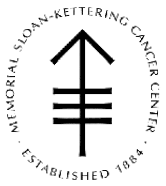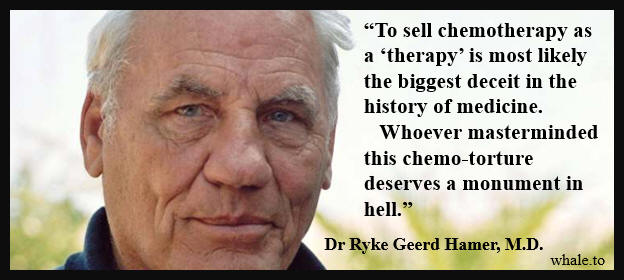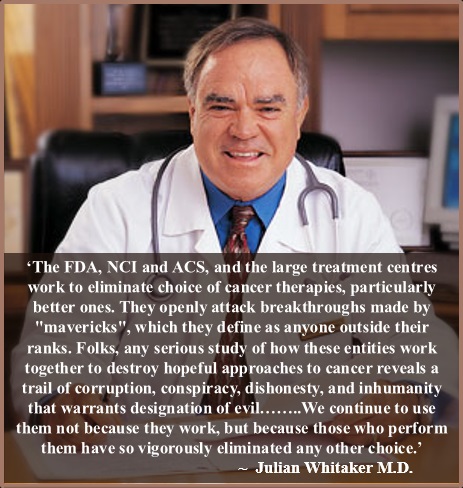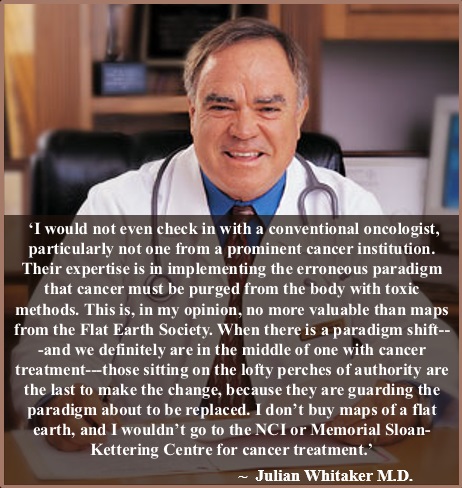
Memorial Sloane Kettering (MSK)
[back]
Hospitals, Clinics
[The original sup
pressor of Laetrile.][2012 May] WHEN MASS MURDER BECOMES ACCEPTABLE by Jon Rappoport
The Ralph Moss Story by Ralph Moss
[Orthomolecular Medicine News Service October 7, 2008] Chemotherapy Doesn't Work, So Blame Vitamin C
See: Bristol-Myers Squibb


Ryke Geerd Hamer, M.D.
Chemotherapy


Quotes
“Here’s what happened. They began a series of tests on Laetrile and they turned it over to their top laboratory technician Dr. Kanematsu Sugiura, a Japanese fellow, he was sort of at the end of his career. He was very well known, held at high esteem by all of his associates. He was mr laboratory test. Whatever Sugiura said, went, for everybody, so they gave it to Sugiura. Sugiura ran his tests and this was his report. He came to five conclusions. First of all, he said, it improved the general health of the mice that he was using. Secondly it appeared to relieve their pain. Thirdly it inhibited the growth of tumors. Fourth it stopped the spread of tumors.. and five it acted as a cancer prevention. That was his official finding. And at the end of this report, this is a quote ‘ Dr has never observed complete regression of these tumors in all his cosmic experience with other chemotherapeutic agents’ end quote.”.....“Congressman John Kelsey used the Freedom of Information Act to obtain a copy of the minutes of the board of directors of Sloan Kettering dated July 2nd 1974. And from the minutes it said quote ‘Sloan Kettering is not enthusiastic about studying Amygdalin, but would like to study cyanide releasing drugs.’ end quote. Now if you understand that sentence you understand everything that I’m talking to you about today.” [G. Edward Griffin] The Science and Politics of Cancer A discourse by G. Edward Griffin
"The (MSKCC) Memorial Sloan-Kettering Cancer Center report on amygdalin, or Laetrile(:) It is incomplete because at least half a dozen experiments with amygdalin performed at the (MSKCC) between 1972 and 1976 have been omitted from the report. (These,) the positive experiments (showing effectivity against cancer) with amygdalin, carried out by veteran researcher Kanematsu Suguira appear to be valid and are not successfully challenged by the report. (In contrast,) there are numerous errors in many of these (reported) experiments which allegedly prove amygdalin's ineffectiveness as a palliative or cure for cancer." - Second Opinion, Special Report: Laetrile at Sloan Kettering, 1977, published January 1978.
As an explosive internal issue, the laetrile affair has almost attained the order of magnitude of the Vietnam conflict. I still do not see how some of the exponents of official American cancer medicine, and certain bureaucracies in Washington, are going to emerge from this affair with clean hands. The effect of this bitter almond substance is not strong, and can be observed only if the defense mechanisms are in operation. In any event, it can and was clearly proven both clinically and experimentally, with positive results, at both the famous Sloan-Kettering Institute in New York, and at the Pasteur Institute in Paris. An enormous suppression story was leaked to the press by a member of the New York institute. A rather mysterious "testing" in five clinics, including the famous Mayo Clinic, led to the strong suspicion that certain oral (not intravenous) doses of laetrile were tested after having been previously and intentionally "contaminated" at the National Cancer Institute in Washington, with a certain highly poisonous cyano urea combination. Officially, a "purification" was admitted. Dr. Hans A. Nieper of Germany has this to say about B–17
Basically the attitude was best expressed by Lewis Thomas, the president of the
centre, who told my boss, as he would not see me, "I am not going to die on the
barricades for
Laetrile. It is not a cure, it is only
a palliative, (meaning it relieves pain and stops the spread of cancer), if it
were a cure it might be a different story, but I am not going to give up my
career, to die on the barricades". That's how they justified it in their own
minds. I could not do that, nor could Dr. Sugiura, who never
renounced the results of his own studies, despite the fact they put enormous pressure on
him to do so.
If you look at the board of
directors of MSK you will find that the drug industry has a dominant position on that board. One
company in particular, Bristol Myers, which produces between 40 -50% of all the
chemotherapy in the world, and they have top positions at MSK hospital.
They are selling their own drugs to that particular hospital but they have written
into the by-laws of the centre that it does not constitute a conflict of interest to sell
their company drugs to the centre. They get around it by not taking a salary. They are not
paid, they are volunteers. Look what happens. You have a man like Benno Schmidt, who was
first head of the president's cancer panel under Nixon, then becomes head of MSK. He then
goes on using the knowledge he gained at MSK to set up his own drug company to make tens
of millions of dollars......The chairman of the board of Bristol Myers, the main company producing anti-cancer
drugs, who also happens to be on the board of MSK, is also on the board of the
New York Times. Everybody's brother in law is an oncologist, or on the board of
somebody else's something or other, so it is a money making thing for the
establishment. A hundred and seven billion, with a B, dollars a year business,
and we are not going to get rid of it easily. Interview of Dr Ralph Moss, Ph.D.
Certainly one story that needs to be told is that of Dr. Kanematsu Sugiura. In 1975, Dr. Sugiura was, and had been for some years, one of the most respected cancer research scientists at Sloan-Kettering. In working with cancerous mice, Dr. Sugiura found that, when he used Laetrile on these mice, seventy-seven per cent of them did not develop a spread of their disease (metastatic carcinoma). He repeated this study over and over for two years. The results were always the same. Dr. Sugiura took his findings to his superiors at Sloan-Kettering, but his study was never published. Instead, Sloan-Kettering published the results of someone else who claimed that he had used Dr. Sugiura's protocol. This "someone else's" study showed that there were no beneficial effects from the use of Laetrile. Dr. Sugiura complained. He was fired. A book was written about all of this entitled The Anatomy of A Cover-up. This book has all the actual results of Dr. Sugiura's work. These results do, indeed, show the benefit of Laetrile. Dr. Sugiura stated in this book, "It is still my belief that Amygdalin cures metastases." Amygdalin is, of course, the scientific name for Laetrile. ALIVE AND WELL by Philip E. Binzel, Jr., M.D.
The people on Sloan-Kettering's Board of Directors were a "Who's Who" of investors in petrochemical and other polluting industries. In other words, the hospital was being run by people who made their wealth by investing in the worst cancer-causing things on the planet. CEOs of top pharmaceutical companies that produced cancer drugs also dominated the Board. They had an obvious vested interest in promoting chemotherapy and undermining natural therapies. The Chairman and the President of Bristol-Myers Squibb, the world's leading producer of chemotherapy, held high positions on MSKCC's Board. Of the nine members of the Hospital's powerful Institutional Policy Committee, seven had ties to the pharmaceutical industry. The Hospital itself invested in the stock of these same drug companies. Directors of the biggest tobacco companies in the U.S., Phillip Morris and RJR Nabisco, held places of honor on the Board. Six Board Directors also served on the Boards of The New York Times, CBS, Warner Communications, Readers Digest, and other media giants. The Ralph Moss Story by Ralph Moss